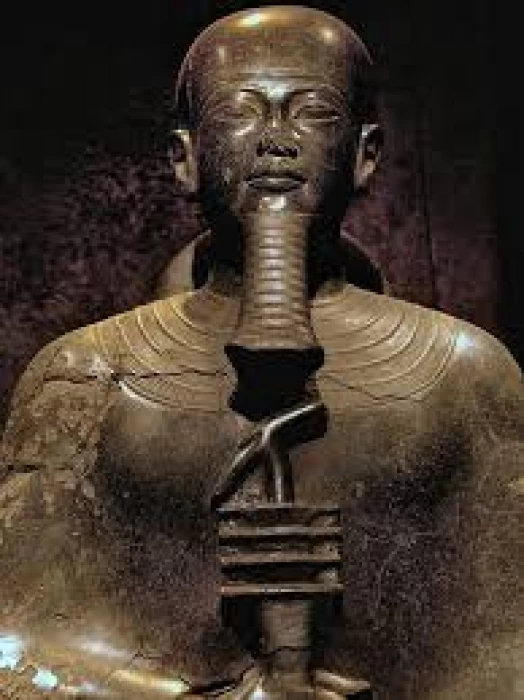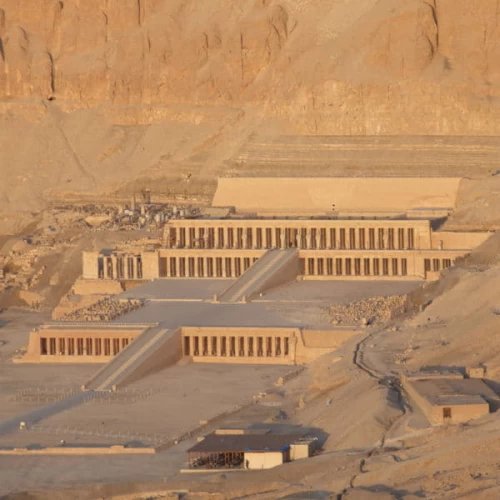
God Ptah | le Dieu de la création et des artisans
Dieu Ptah, le Dieu de la création et des artisans
«Ptah» dans la religion égyptienne ancienne est le dieu en qui réside le pouvoir du processus de création et la première divinité de la création. Par conséquent, tous les rois d'Égypte qui l'ont gouverné pendant de longues périodes lui ressemblaient. Les Égyptiens croyaient qu'il était le créateur, l'inspiration et le protecteur des artistes, faisant de lui l'idéal des artistes. Ptah était le grand prêtre de son temple à Memphis aussi le dieu de l'artisanat. Il faisait partie de la Triade de Memphis avec sa femme Sekhmet (l'une des divinités les plus anciennes et les plus puissantes. Représentée comme une lionne, la fille du dieu soleil Amon Ra, et est connue comme la déesse du soleil et de la guerre) et Nefertum ( il représente le lever du soleil, et on dit qu'il a créé l'humanité de ses larmes). Ptah a également organisé un rituel important appelé (Ouverture de la bouche), un rituel funéraire visant à garantir que la personne décédée puisse manger et boire dans l'au-delà.
Dans l'Ancien Empire, il était déjà identifié à Sokar, le dieu de la nécropole de Memphis: Ptah et Sokar unifièrent ainsi la cité des vivants avec la cité des morts. Une autre identification, qui se déplace d'Osiris en tant que dieu des morts, conduit à la formation de Ptah-Sokar-Osiris, en tant que divinité transcendante à Memphis et, maintenant. A partir du Nouvel Empire il retrouve son individualité, il est le mari de la déesse Sekhmet et le père du dieu Néfertum.
Voyagez en Égypte pour visiter les temples et pyramides égyptiens pour en savoir plus sur la mythologie et les centaines de dieux adorés par les pharaons qui ressemblaient beaucoup aux humains qu'ils aimaient et détestaient. Ils se sont sentis jaloux et se sont battus et sont morts au cours d'un mythe étonnant plein de joie, des événements d'action et dramatiques qui ont inspiré les réalisateurs et producteurs de films modernes à créer des films de renommée mondiale sur la grandeur des pharaons et des dieux qu'ils adoraient. Passez quelques jours à visiter Abydos, Gizeh, Louxor, Assouan pour voir les tombes des pharaons ornées de scènes très claires, détaillées et magnifiquement peintes des différentes divinités de l'Égypte ancienne ainsi que de nombreux autres sites.
Naviguez sur les eaux bleues à travers les deux bandes verdoyantes de part et d'autre du désert doré lorsque vous réservez votre croisière sur le Nil égyptien. Et consultez nos offres saisonnières pour choisir la pension ou la maison de vacances la plus adaptée à vos vacances de Pâques 2023. Nous vous épargnerons les tracas et inclurons certains des meilleurs hôtels et bateaux dans toutes les villes que vous allez visiter par le biais de forfaits de voyage en Égypte. Mais si vous aimez réserver votre propre hôtel, nous avons professionnellement personnalisé une grande variété d'excursions d'une journée en Égypte pour vous. Commencez dans la ville qui ne dort jamais et explorez nos excursions d'une journée au Caire qui couvrent tous les sites archéologiques et les lieux de divertissement à partir des pyramides de Gizeh, le célèbre Sphinx et au Musée égyptien situé sur la place El Tahrir et le Musée national de la civilisation égyptienne pour admirer le masque d'or du roi Toutankhamon. Et si vous avez envie de camper dans l'un des déserts les plus fascinants du monde, nous avons créé les circuits du désert blanc. Voyagez en toute sécurité avec nous en Haute-Égypte et réservez nos excursions d'une journée à Louxor et voyagez plus au Sud vers l'étonnante Nubie et explorez toutes les options que nos excursions d'une journée à Assouan peuvent vous offrir.
Ptah was the high priest of his temple at Memphis and also the god of Crafts. He was one of the Triad of Memphis with his wife Sekhmet (one of the oldest and most powerful deities. represented as a lioness, the daughter of the sun god Amun Ra, and is known as the goddess of sun and war)and Nefertum (he represents the sunrise, and it is said that he created mankind from his tears).
Ptah also held an important ritual called (Opening of the Mouth), a funerary ritual to ensure that the deceased person would be able to eat and drink in the afterlife.
In the Old Kingdom, he was already identified with Sokar, the god of the necropolis of Memphis: Ptah and Sokar thus unified the city of the living with the city of the dead. A further identification, which moves from Osiris as the god of the dead, leads to the formation of Ptah-Sokar-Osiris, as a transcendent divinity in Memphis and, by now. Starting from the New Kingdom he regains his individuality, he is the husband of the goddess Sekhmet and the father of the god Nefertum.
Path
- Lord of Ankh Tawy 'The Life of the Two Lands' refers to the unification of Upper and Lower Egypt.
- Nefer Her "Ptah with a beautiful face" refers to the belief that his flesh was made of gold.
- Ptah-Sokar-Osiris : At the end of the period (737–332 BC), the combined traits of the gods gained popularity, and this composite deity assisted the deceased in his trip to the afterlife. A carved wooden statue of the composite god was among the funeral items placed inside the tomb containing the deceased.
- Ptah-Sokar-Atoum's affiliation with the deity of the dead, Sokar, and the creator god of Heliopolis, Atoum, shares many characteristics with Osiris.
Ptah is depicted as a man with green skin, sheathed in a very tight-fitting shroud and capped with a simple blue cap; he holds vertically in both hands a composite scepter bringing together: the sceptre Ouas, the cross ânkh and the pillar Djed, the emblems of life, stability and omnipotence. Unlike the other gods, he wears the straight beard of the pharaohs. Around the neck it has a wide collar held in place by a counterweight on the back. Sometimes, it rests on a pedestal (base of the throne) which has the shape of a hieroglyph and whose meaning is also a symbol for Maât ("world order").
Present the architectural wonders dedicated to Ptah:
The great temple of Ptah in Memphis: A complex that radiated power and divinity, becoming the beating heart of the worship of Ptah.
Other curiosities: The minor temples and altars scattered across Egypt reveal the extent of his adoration.
Beautiful decorations and artwork that honoured Ptah's strength and inventiveness were found inside the temples.















